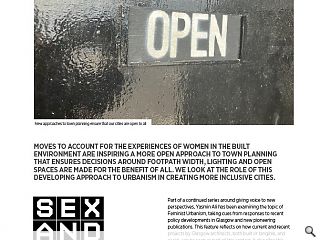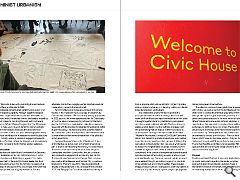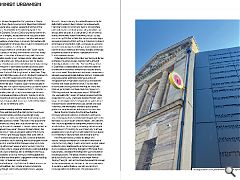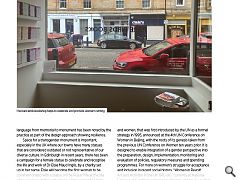Feminist Urbanism: Sex and the City
22 Jul 2024
Moves to account for the experiences of women in the built environment are inspiring a more open approach to town planning that ensures decisions around footpath width, lighting and open spaces are made for the benefit of all. Yasmin Ali looks at the role of this developing approach to urbanism in creating more inclusive cities.
Part of a continued series around giving voice to new perspectives, Yasmin Ali has been examining the topic of Feminist Urbanism, taking cues from responses to recent policy developments in Glasgow and new pioneering publications. This feature reflects on how current and recent projects by Glasgow architects, both built or tangible, and social, can be seen as part of this context. It also sites this framing as of a more representative and egalitarian approach to designing the city and notes how this relates to current and changing gender and societal attitudes.
Gender and The City does not have the same assonant catchiness as the title of the hit sitcom yet has been an established focus of sociological debate since the eighties. Doreen Massey, geographer and Professor, brought the impact of space and place on gendered experiences into the fore of discourse, in her work, publishing the seminal book ‘Space, Place, and Gender’ in 1994. Developing concepts aired earlier by sociologists of on gender-shaped geography, Massey’s research reshaped the rhetoric of gender at the city and has been noted as influencing today’s respected thinkers and speaker regarding Feminist Urbanism, including May East, author of recent publication ‘What if Women Designed the City: 33 leverage points to make your city work better for women and girls’. It is the most readable and accessible doctorate-level research I have come across, with the leverage points easily identifiable and digestible in separate numbered subsections. East is currently active in a series of engagement projects, throughout Scotland, where she is based, and internationally, that bring her book to both informed and lay audiences. East has also contributed to and commented on Glasgow’s recent declaration as the UK’s first feminist city in terms of city development.
Reflecting on a year of this status, she notes that for Glasgow City Council leadership, their next steps are to ensure that the feminist city approach is embedded in all aspects of the city, not just within planning and development, including representation. She also advocates that further engaging women and their views can create urban change to the benefit of all. Feminist Urbanism in its Glasgow context, first came to the fore in the media with news coverage of Glasgow City Council’s endorsement of Feminist town planning approaches in 2022, backing the motion spearheaded by the Green party at the time. Novel and newsworthy, not least for the fact it was the first UK city or municipality to take this progressive viewpoint with the intention to integrate it meaningfully within its planning policy. This has been picked up by the national and mainstream press, and reported on with enthusiasm and a sense of fervour that seems to match that of the attitudes within governance. Last year Glasgow School of Art’s Mackintosh School of Architecture co-led an event on Feminist Urbanism as part of a series on Relearning Place run by The Glass-House.
The latter is a national charity who champion design to connect and empower communities through co-design and collaborative engagement, as noted by their full title: The Glass-House Community Led Design. Their invitation was a call redefine Glasgow as a Feminist City to celebrate International Women’s Day 2023. This provocation built directly on the excitement of the campaign that in October 2022, saw Glasgow City Council became the first UK city to back a proposal which will see Scotland’s largest city make women central to all aspects of planning, public realm design, policy development and budgets. The collaborative event promised to explore the principles and theories behind creating a feminist urban realm, and how these can impact and redefine the city today. It brought together students, practitioners, policymakers and citizens work collaboratively with The Glass-House, to explore and co-design creative methods of engagement and placemaking that can help us redefine our places as more inclusive. Tutoring at this event under the moniker ‘Missing In Architecture’, a group of GSA Studio Tutors who cite as their mission to promote creativity and action within the profession, not least by, in their own words, filling in the gaps about architecture that they care about, which seems to include the marginalisation of groups including women. Labelled as ‘agitators’ in AJ series of features is a definite compliment, in the context of disruption as desirable against systemic barriers within existing accepted practices in our post-neoliberalist age.
One response explored at their event was a series of thought-provoking images of non-feminist or inequitable built environment realities. These included images of raised curbs at crossing points, stair-only options at thresholds to public transport spaces, religious propaganda posters and uneven street surfaces. The collective continued meaningful citizen engagement with a follow-up event as part of The Architectural Fringe, a photo-walk to capture the individual experience of moving through the city of Glasgow. In providing a variety of starting points and a single end point to the walk, we will all take different routes and come across different obstacles or opportunities, they were able to correlate these multitude exchanges, by plotting these onto a map. The resultant picture begins to emerge of the intersectional experiences in our shared city. The key questions they asked could be extended to any group of city users - Who do these spaces affect? How do they make you feel? Why are they problematic or work well? How can they be made better? True to their headline as ‘architectural antagonists’ MiA raise questions that are searching for design problems and their solutions via identifying these.
As aforementioned, May East is also considered a design innovator, particularly regarding the gender-sensitive approach to planning and design, and a key figure in the Feminist Urbanism movement, both in Scotland and internationally. Known for her recent groundbreaking book ‘What if Women Designed the City’ published in May by Triarchy Press, she is renowned as an International Urbanist and Regenerative Designer. Recipient of Women of the Decade in Sustainability and Leadership Award at the Women Economic Forum in 2019, and working with the UN, her book is bringing this solutions-driven discourse to both high level and grassroots audiences, the latter well-served by a roadshow of workshops in progress, that partner with interesting platforms that also help elevate their presence and audiences as well as launch the book. One such event is in conversation with Russell Napier, at The Library of Mistakes, an innovative free-to-use library dedicated to the study of financial history, with the hopes of avoiding repeating past mistakes, and a hidden gem in Edinburgh’s West End. They will discuss how the double mistake of modernism and motorisation in post-war planning and development has hindered women’s access to urban spaces. Another interesting space for civic engagement is UN House Scotland’s Edinburgh branch in New Town.
They hosted a UNHS Cities series, of which May East’s book launch was the first of three planned events in May of this year that centred on looking at how policy affects communities. RIAS, from their base in Rutland Square which includes its bookshop, also hosts public-facing events, such as the launch in June of RIBA Book ‘100 Women: Architects in Practice’, a book profiling through in-depth interviews a global cross-section of female practising architects. It aspires to aim to raise the profile of women architects, from its early positive responses, it may parallel the success of what ’40 Architects Under 40’ did for emerging talent. Architects advancing inclusive approaches Bookshops and libraries fulfil a vital function in our towns and cities Rare Birds Bookshop, in Edinburgh’s leafy Stockbridge, is a bookstore which welcomes everyone and celebrates books by women. They host a lively programme of community activities, and a subscription service. In its own way, it is part of a network of feminist spaces within the city that welcome women. Glasgow Women’s Library has found its forever home in Bridgeton and benefits the area as part of the Clyde Gateway regeneration. After various iterant premises around the city, GWL is sited in a restored and modernised historic building, that has an elegant modern addition of an external lift that has been wrapped in metal cladding with cut out names of women writers.
Collective Architecture, who re-engage and redevelop existing buildings for public use so effectively, also re-animated Civic House, in Cowcaddens, which is a thriving co-working space and canteen that also hosts public engagement events including workshops, conferences, and markets. These built projects by Collective Architecture are more than just buildings: they engage, activate and animate our city through community and their function. Glasgow Women’s Library is the only Accredited Museum in the UK dedicated to women’s lives, histories and achievements. Their library collection is home to ‘hard to find anywhere else’ books by, for and about women, all by donations over the past three decades. It is a venue for GI, the art biennial festival, and recently hosted ‘Performing Voices’, a 3-day course run by GSA Future Skills that focused on reflecting on personal responses to GWL’s archive, culminating in a closing performance and exhibition night. Civic House is a welcome venue for inclusive events, including a recent conference for women of colour working in the media, including workshops and panel discussions on diverse representation in the Scottish media landscape. Collective Architecture’s founding members Jude Barber and Nicola McLachlan co-lead, together with Edinburgh University academic and architect Suzanne Ewing, ‘Voices of Experience’, a collaborative project that celebrates the contribution of overlooked women in architecture and the built environment. They document and record conversations between experienced female built environment professionals and young women architects, forming an archive of intergenerational conversations to preserve and celebrate expertise that would be otherwise lost.
They also have an active public-facing presence with regular events that often ask participants to activate their civic presence. In 2019, they produced the newspaper project ‘REMNANTS: How you build a City’, as part of their engagement with the programme ‘Of Lovely Tyrants and Invisible Women’ which sought to re-imagine and re-configure urban spaces based on discriminatory and entrenched class, gender and racial hierarchies, and interrogated themes of spatial politics, gender and racial hierarchies within imperial architecture. Becca Thomas, Creative Director at New Practice, previously worked at Collective Architecture, and now co-runs a thriving practice based between Glasgow and London that holds inclusivity as part of its key values. Like Collective, New Practice’s approach to championing inclusion extends to both built and social projects, including publications and programmes. Its ‘A Building for your Community’ is a freely available online resource archive with comprehensive guides on community-led development and accessible spaces.
New Practice recently unveiled its design for a national Transgender Monument to be built in the heart of Manchester’s Gay Village. It was a response to an open callout architects run by Sparkle and Arup, to trans and gender diverse designers, artists for a Transgender Memorial. Plans were carefully considered following a two-year consultation and design process. The design tectonics respond to trans attributes of reflection, resilience and strength. Named ‘Passing The Light’, lead architect Bek Ziola notes this concept for the monument imparts the hope to the trans community: ‘if you can live authentically as yourself, you will in turn encourage others to do the same’. The conscious shift in language from memorial to monument has been noted by the practice as part of the design approach showing resilience. Space for a transgender monument is important, especially in the UK where our towns have many statues that are considered outdated or not representative of our diverse culture. In Edinburgh in recent years, there has been a campaign for a female statue to celebrate and recognise the life and work of Dr Elsie Maud Inglis, by a charity set up in her name. Elsie will become the first woman to be commemorated with a statue on the Royal Mile at the site of her hospice on the High Street, a first amongst 12 men statues. Numerous other movements for women statues are active, including campaigns run by Statues for Equality, Monumental Welsh Women and The Womenchester Statue Project.
It is uplifting to see architects design inclusively regarding gender sensitivity and allyship, and the inclusion of trans people would be an expected progression of the gender sensitive discourse that so strongly advocates for feminist urbanism. Gender mainstreaming is a strategic measure designed to combat systemic discrimination between men and women, that was first introduced by the UN as a formal strategy in 1995, announced at the 4th UN Conference on Women in Beijing, with the roots of its genesis taken from the previous UN Conference on Women ten years prior. It is designed to enable integration of a gender perspective into the preparation, design, implementation, monitoring and evaluation of policies, regulatory measures and spending programmes. For more on women’s struggle for acceptance and inclusion in recent social history, ‘Women in Revolt! Art and Activism in the UK 1970-90.’ currently at National Galleries of Scotland, explores key themes and issues, such as the Women’s Liberation Movement, maternal and domestic experiences, Punk and independent music, Greenham Common and the peace movement, the visibility of Black and South Asian women artists, Section 28 and the AIDS epidemic. A shift is needed to allow for the provision and inclusion of all genders within urbanism as well as all aspects of society, as well as approaches that allow for intersectionality, intergenerational integration and allyship in order to be truly inclusive.
|
|






